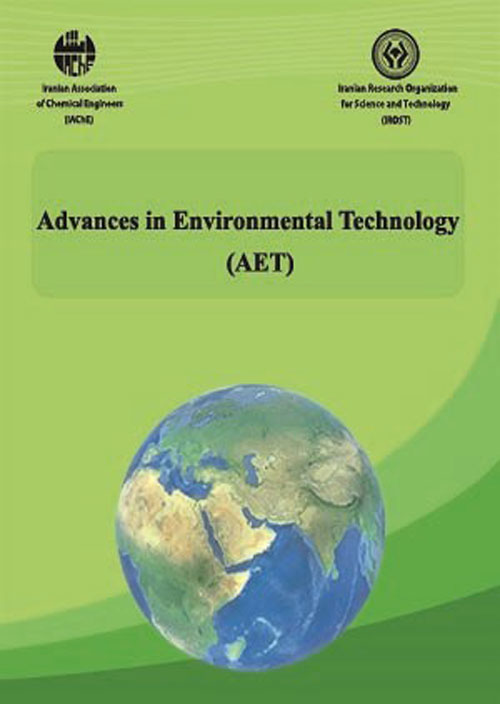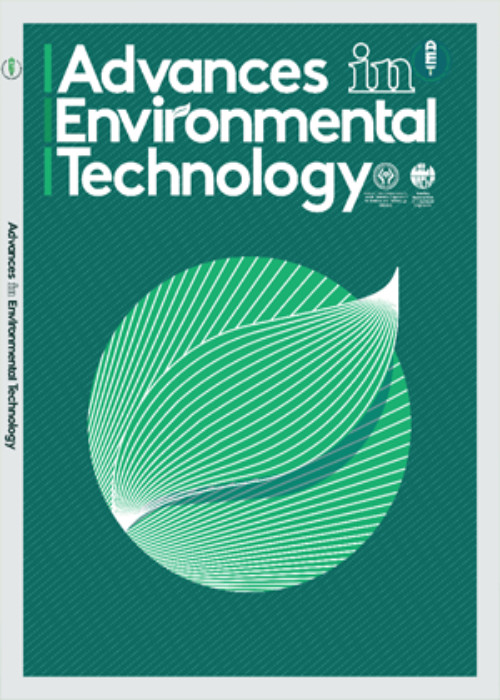فهرست مطالب

Advances in Environmental Technology
Volume:6 Issue: 3, Summer 2020
- تاریخ انتشار: 1400/06/17
- تعداد عناوین: 6
-
-
Pages 131-138It is essential to assess flood risk mapping for sustainable development. The present study aimed to identify the causes of flooding and predict the extent of damage caused in the area of Miyandoab, Iran. The Driver, Pressure, State, Impacts, response (DPSIR) conceptual framework model was used to analyze the factors affecting flooding in the region. DPSIR is a system approach that identifies key relationships between humans and the environment, and its combination with the simple additive weighting (SAW) model identifies a new strategy for achieving sustainable development. The DPSIR method for flood susceptibility analysis in the region, examined the social, economic, physical, and environmental factors as the driving force. The flood risk level was then determined for the region by preparing the driving force map and mapping the region. For this purpose, the decision-making trial and evaluation laboratory (Dematel) and SAW models were used to investigate the causal relationship between the factors and calculate the weight of layers; Matlab software was used to implement the models. Finally, based on the weights extracted from the SAW method, risk mapping was performed in the geographic information system (GIS) environment. The results showed that out of the total area of the study area, about 78,462 hectares have a high risk, 91,542 hectares have medium risk, and 2,952 hectares have a low risk of flood. The results from combining the models of decision support systems and GIS indicated high efficiency in determining the areas with a high risk of flood.Keywords: Flood plain, Sustainable Development, Flood Risk Mapping, Matlab
-
Pages 139-148
Lead acetate is the most common coagulant used in quality control laboratories in the sugar industry to clarify juice samples. Due to its known poisonous effects, health hazards, and extremely harmful impact on the environment, this study focused on finding an alternative coagulant that was efficient, safe, cost-effective, and eco-friendly. A powder made from Moringa oleifera (M.o) seeds, which is rich in phytochemicals with antimicrobials, was tested to produce a natural coagulant capable of clarifying the juice samples. The produced coagulant proved efficient and was potentially characterized by a better environmental performance than the extremely harmful lead acetate. An amount of three grams of M.o seedpowder proved to be an effective coagulant, achieving a 64.14 % removal of non-sugar compounds and led to the correct sugar polarimetric measurements. There is no way to compare the exorbitant price of lead acetate to the cost of naturally and available occurring Moringa seeds. The adsorption process was described by three adsorption isotherms, which were applied to evaluate the adsorption equilibrium.
Keywords: Coagulation, lead acetate, Moringa oleifera seeds powder, sugar beet (Beta vulgaris L.) juice, cheap, echo friendly precipitant -
Pages 149-159In this research work, the performance and the exhaust emissions of a CI engine operating on diesel-biodiesel-ethanol blended fuels were investigated. The main purpose of this study aimed to reduce the various emissions produced by the new blended fuels. The conventional transesterification reaction was carried out to produce biodiesel from Jatropha seeds. A one-cylinder, four-stroke CI engine was powered by green blended fuels at various engine speeds. Response surface methodology (RSM) was exploited to analyze the performance and exhaust emission parameters of a diesel engine in terms of fuel blends and engine speed. According to the results obtained, an engine speed of 2657 rpm, a biodiesel concentration of 10.26%, and an ethanol ratio of 2.21% were found to be the optimal values. The obtained experimental results showed that adding ethanol-biodiesel to pure diesel fuel increased the diesel engine's performance, including power and torque output. The results also showed that the CO2 emission increased 9.6 % while CO, NOX, and HC emissions in the biodiesel-ethanol-diesel fuel decreased 1.33%, 5%, and 26.1 %, respectively, compared to pure diesel fuel. The specific fuel consumption of the new blended fuel decreased by 6.9 % compared to pure diesel fuel.Keywords: Biodiesel-ethanol-diesel, Emission, Performance, Jatropha, Response surface method
-
Pages 161-166Natural dyeing has regained its popularity in order to keep the environment clean and safe by reducing the use of harmful chemicals in the dyeing process. Consequently, different natural dyestuff has been used in textile coloration: marigold, henna, onion skin, roots, and tree bark. Among these dyestuffs, tea has been used for the coloration of textiles. Around the world, including Bangladesh, a lot of tea is consumed on a daily basis. After consumption, the tea residue is disposed of in open spaces, which is considered a source of environmental pollution. Due to the adverse effect on the environment, this experiment used tea residue to dye wool/acrylic blended yarn to make the dyeing process more eco-friendly. Four different mordanting agents were used to determine the one most suitable for dyeing wool/acrylic blended yarn using tea residue. To evaluate the performance of the dyed yarn, the color-coordinate value and different colorfastness properties were measured.Keywords: Tea residue, dyeing, wool, acrylic yarn, colorfastness
-
Pages 167-172Among the biological processes, bioleaching is the most widely employed method for metal extraction from electronic waste (e-waste). The purpose of this research was to evaluate the ability of one-step and two-step bioleaching under different culture media for nickel (Ni) and cadmium (Cd) removed from spent Ni-Cd batteries by the fungus Aspergillus niger. In this result, the concentrations of Ni and Cd in battery scraps from e-waste recycling shops were respectively 578.13 ± 7.02 mg Ni g-1 and 128.35 ± 11.42 mg Cd g-1. During the bioleaching process, both heavy metal removals were higher in Richards’s Broth (RB) followed by the Potato Dextrose Broth (PDB) and Malt Extract Broth (MEB), respectively. The maximum citric acid production (96.99±3.05 mM) and lower pH values were obtained in the RB medium. The bioleaching experiment showed that the recovery for the two-step leaching method was higher than the one-step bioleaching method. Following an incubation period of 21 days between the spent Ni-Cd batteries and RB medium, the two-step bioleaching experiment suggested that the citric acid products of A. niger were the best leaching agent for Ni and Cd bioleaching.Keywords: Nickel, Cadmium, Bioleaching, Aspergillus niger, Ni-Cd battery
-
Pages 173-189
Previous studies have used molecular dynamics simulation to assess the feasibility of applying vertically aligned carbon nanotube membranes (VA-CNT) for salt water desalination. The presented report experimentally determined the potential of salt water desalination by employing VA-CNT membranes. The VA-CNT membranes were synthesized through the template-assisted pyrolysis of polybenzimidazole-Kapton inside the pores of anodized aluminum oxide (AAO) and characterized by several techniques. The permeability, salt rejection, and biofouling tendency of VA-CNT membranes were measured in various operating conditions; the results were compared with the performance of a commercial reverse osmosis (RO) membrane (BW30). The VA-CNT membrane permeability was about twofold higher than the permeability of the RO membrane. Furthermore, the VA-CNT membranes had higher stability against biofouling phenomena; they also showed antibacterial activity so that about 70% of the adsorbed cells on the VA-CNT membranes were killed by CNTs tips that were vertically aligned on the membrane surface. The rejection efficiency of the VA-CNT membrane was comparable to that of the commercial RO membrane. Finally, the chlorine stability studies showed that high hypochlorite exposure (48000 ppm.h) did not significantly fail the flux and rejection of the VA-CNT membranes, confirming their chemical stability. This study shows the high capability of the VA-CNT membrane in the water treatment process.
Keywords: Vertically aligned carbon nanotube membrane, Desalination, Reverse osmosis, anti-bacterial membranes


